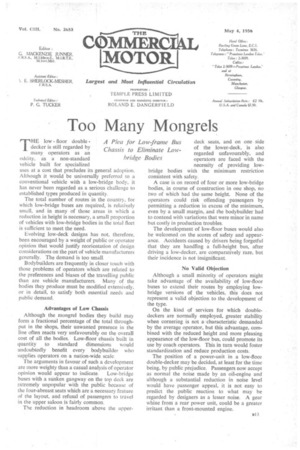Too Many Mongrels
Page 47

If you've noticed an error in this article please click here to report it so we can fix it.
THE low floor double decker is still regarded by many operators as an oddity, as a non-standard vehicle built for specialized uses at a cost that precludes its general adoption. Although it would be universally preferred to a conventional vehicle with a low-bridge body, it has never been regarded as a serious challenge to established types produced in quantity.
The total number of routes in the country, for which low-bridge buses are required, is relatively small, and in many of those areas in which a reduction in height is necessary, a small proportion of vehicles with low-bridge bodies in the total fleet is sufficient to meet the need.
Evolving low-deck designs has not, therefore, been encouraged by a weight of public or operator opinion that would justify reorientation of design considerations on the part of vehicle manufacturers generally. The demand is too small.
Bodybuilders are frequently in closer touch with those problems of operators which are related to the preferences and biases of the travelling public than are vehicle manufacturers. Many of the bodies they produce must be modified extensively, or in detail, to satisfy both essential needs and public demand.
Advantages of Low Chassis Although the mongrel bodies they build may form a fractional percentage of the total through. put in the shops, their unwanted presence in the line often reacts very unfavourably on the overall cost of all the bodies. Low-floor chassis built in quantity to standard dimensions would undoubtedly benefit every bodybuilder who supplies operators on a nation-wide scale.
The arguments in favour of such a development are more weighty than a casual analysis of operator opinion would appear to indicate. Low-bridge buses with a sunken gangway on the top deck are extremely unpopular with the public because of the four-abreast seats which are a necessary feature of the layout, and refusal of passengers to travel in the upper saloon is fairly common.
The reduction in headroom above the upper deck seats, and on one side of the lower-deck, is also regarded unfavourably, and operators are faced with the necessity of providing lowbridge bodies with the minimum restriction consistent with safety.
A case is on record of four or more low-bridge bodies, in course of construction in one shop, no two of which had the same height. None of the operators could risk offending -passengers by permitting a reduction in excess of the minimum, even by a small margin, and the bodybuilder had to contend with variations that were minor in name but costly in production troubles.
The development of low-floor buses would also be welcomed on the scores of safety and appearance. Accidents caused by drivers being forgetful that they are handling a full-height bus, after driving a low-decker, are comparatively rare, but their incidence is not insignificant.
No Valid Objection Although a small minority of operators might take advantage of the availability of low-floor buses to extend their routes by employing lowbridge versions of the vehicles, this does not represent a valid objection to the development of the type.
On the kind of services for which doubledeckers are normally employed, greater stability when cornering is not a characteristic demanded by the average operator, but this advantage, combined with the reduced height and more pleasing appearance of the low-floor bus, could promote its use by coach operators. This in turn would foster standardization and reduce production costs.
The position of a power-unit in a low-floor double-decker may be decided, at least for the time being, by public prejudice. Passengers now accept as normal the noise made by an oil-engine and although a substantial reduction in noise level would have passenger appeal, it is not easy to predict the public reaction to what may be regarded by designers as a lesser noise. A gear whine from a rear power unit, could be a greater irritant than a front-mounted engine.




































































































































